SCAN Weekly Update - 3/26/24
This blog post describes data collected at 8 wastewater treatment plants in the Greater Bay Area of San Francisco, CA, including Sacramento, that are partners in the SCAN project which began in late 2020. The SCAN plants are a subset of the WastewaterSCAN plants.
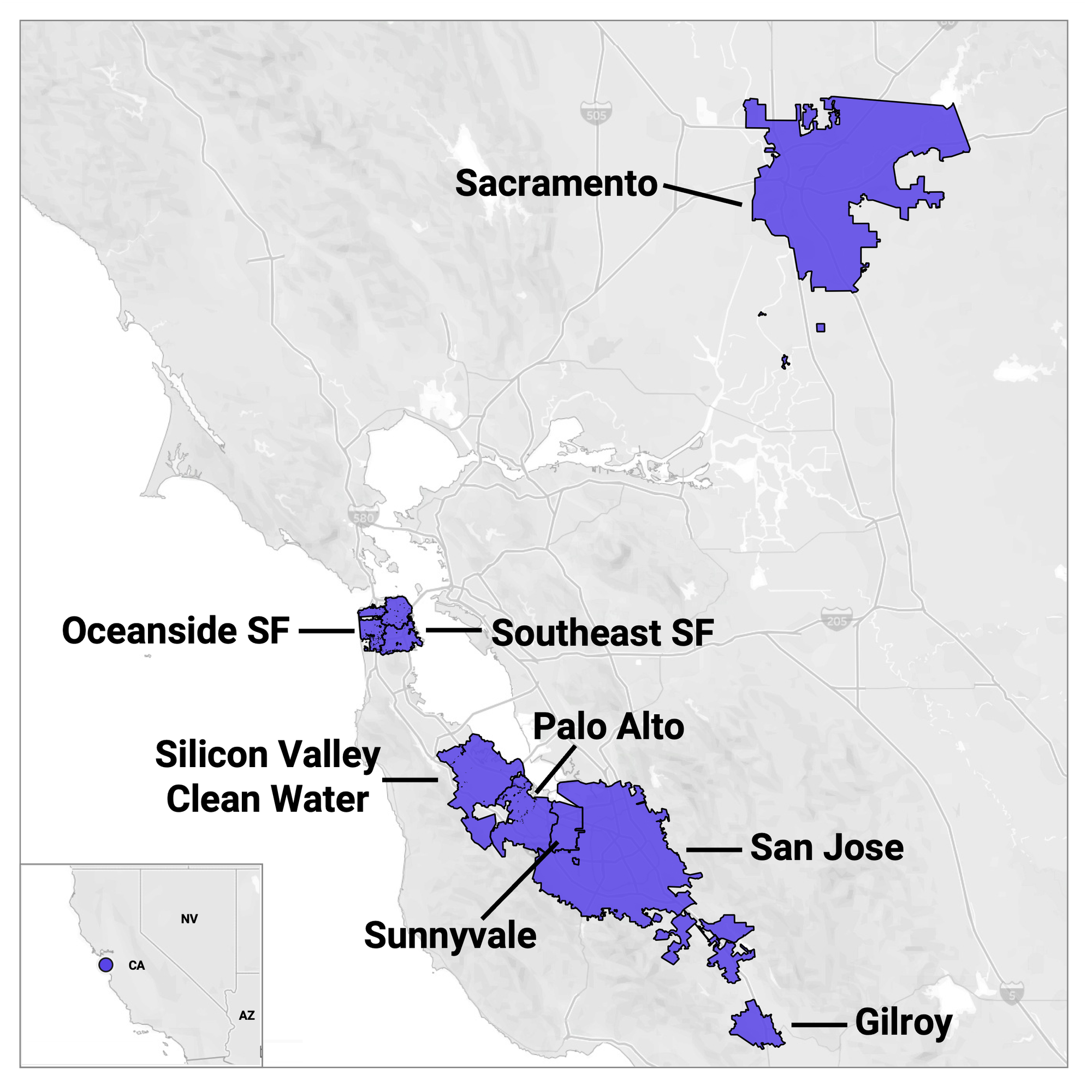
All samples picked up by the couriers as of 3/25/24 have been processed and their data are on the site: data.wastewaterscan.org. Please email Amanda at albidwel@stanford.edu if you identify any bugs on the site.
For site level summaries of the SCAN plants with current Wastewater Categories and concentration plots, see the following links:
For more information about the Wastewater Categorization system (i.e., how LOW, MEDIUM, or HIGH categories are determined for each pathogen), please see "How are wastewater categories determined?" in the About page for WastewaterSCAN.
COVID-19
SARS-CoV-2 concentration in wastewater and sequencing for variants
SARS-CoV-2 N gene concentrations are between non-detect and 574,600 copies/g over the last 10 days. Below are the current SARS-CoV-2 wastewater categories for the SCAN sites (recall the category is determined by both the trend and the level):
- Gilroy, Palo Alto, Sacramento, San Jose, Sunnyvale, and SVCW are in the LOW Wastewater Category for SARS-CoV-2
- Oceanside SF and Southeast SF are in the MEDIUM Wastewater Category for SARS-CoV-2
Below are all the data from all the SCAN plants for the last two years. You can access the graph here. The population weighted average across the SCAN plants is shown in black. The population weighted average is starting to decrease from the last peak.

Below are plots from Oceanside SF, Sacramento, San Jose, and Southeast SF showing the relative proportions of different variants inferred from sequencing the entire genome of SARS-CoV-2. White and grey striped bars indicate no data is currently available for that week. In the most recent samples, JN.1 (bright red) made up the largest proportion of the lineages detected at Oceanside SF (100%), Sacramento (100%), San Jose (96.9%), and Southeast SF (100%). Note that the sequencing data are always from samples taken between 1-2 weeks ago (in this case, March 16, 2024).
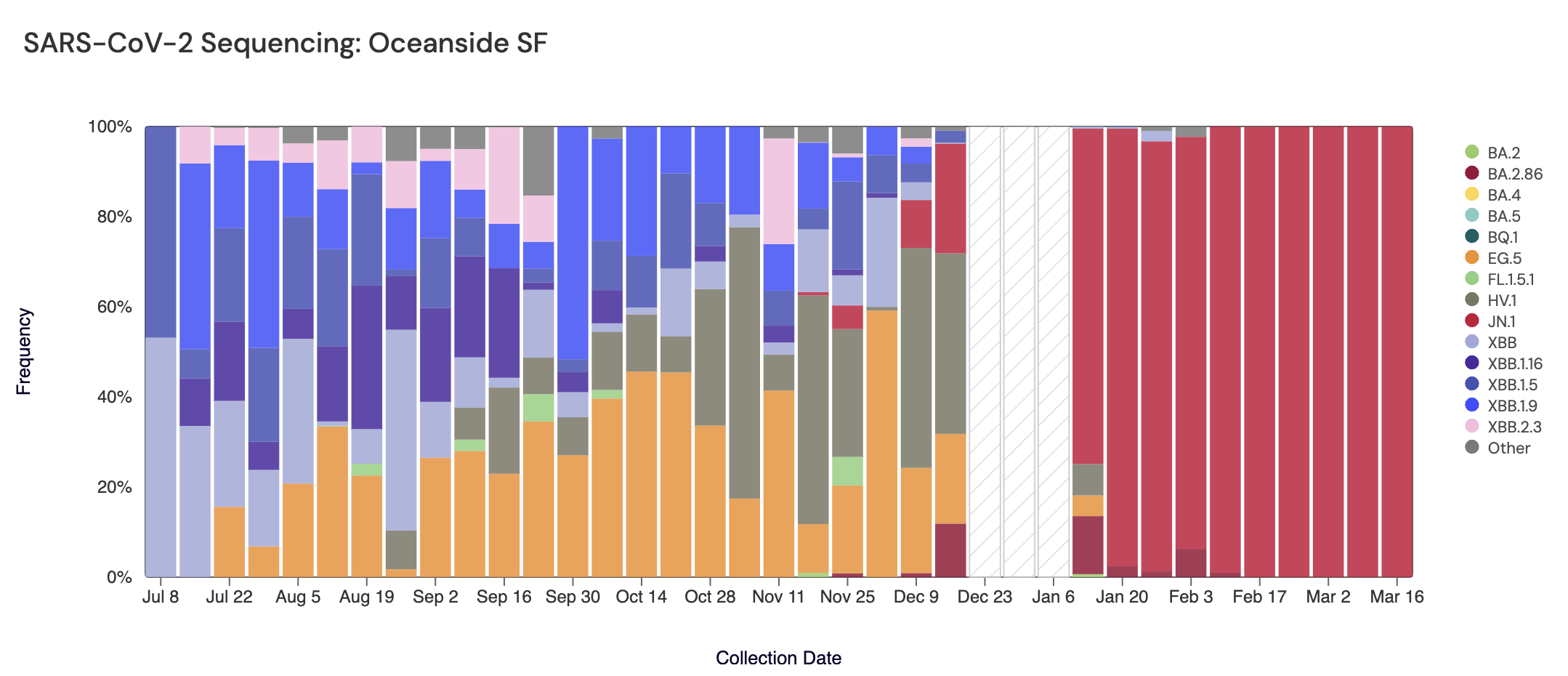
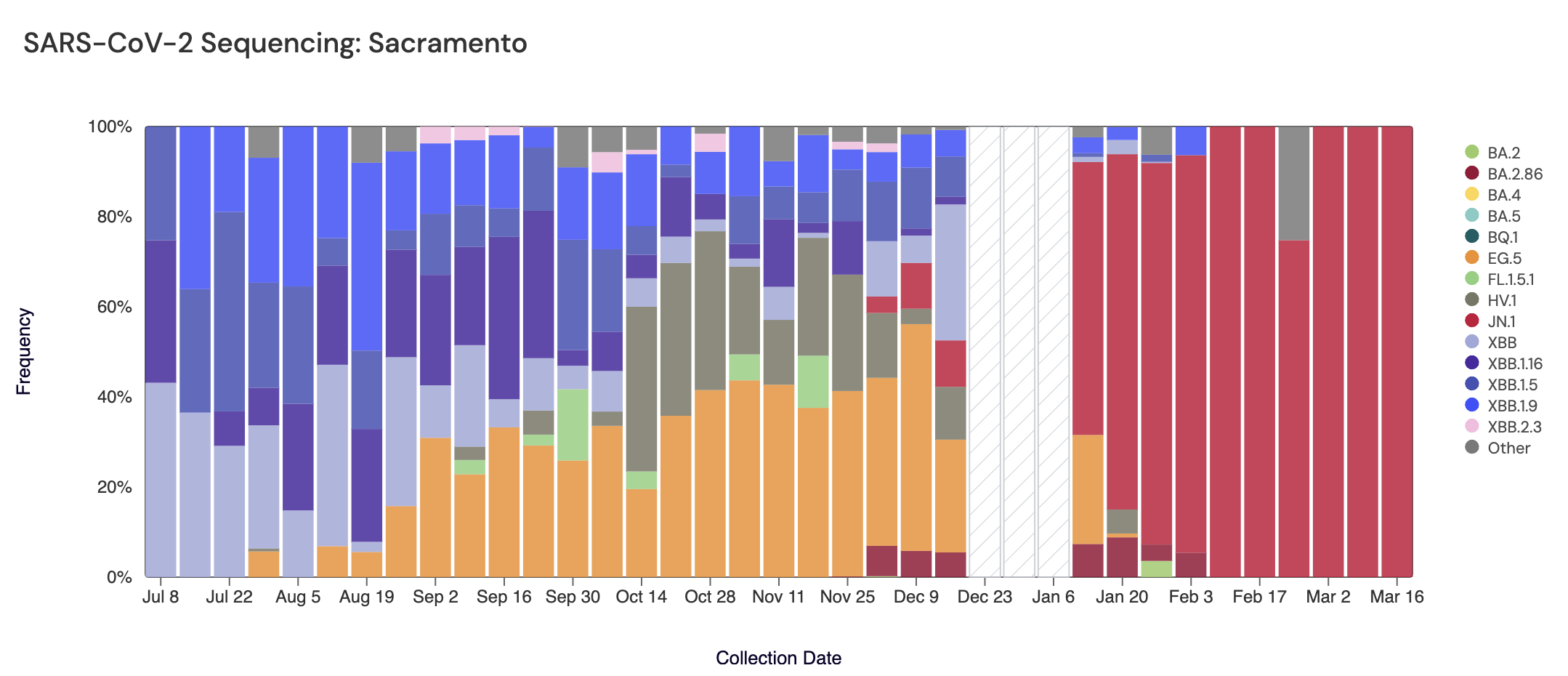
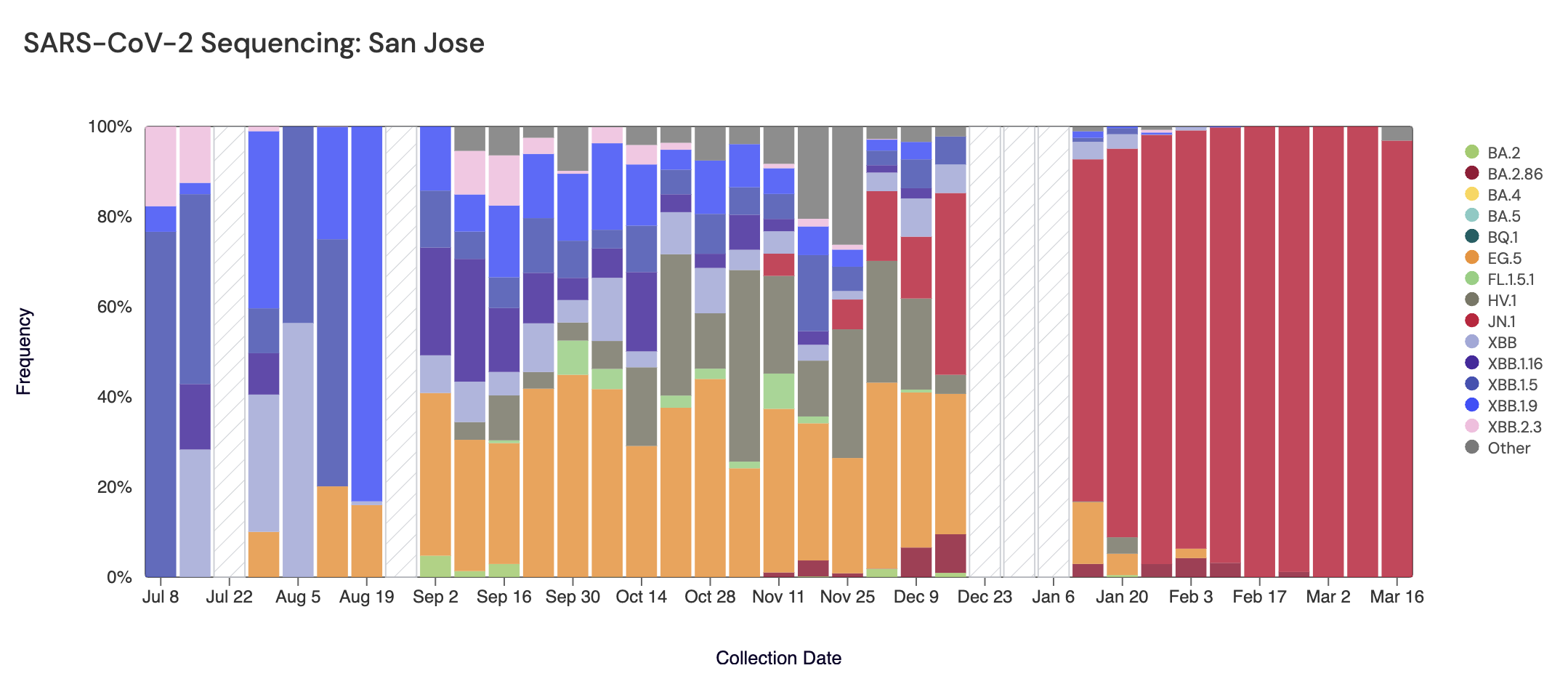
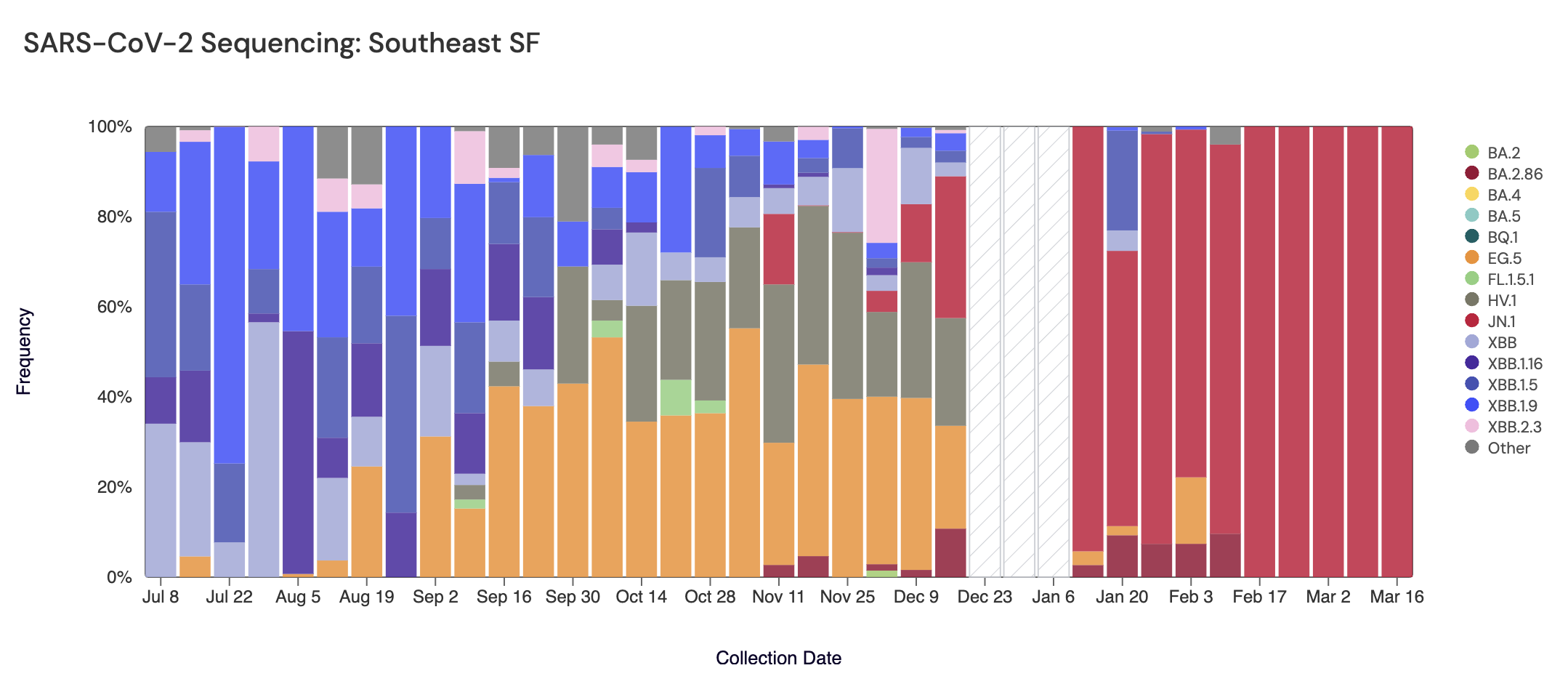
Other Respiratory Targets
Influenza A & B, RSV, HMPV, EV-D68 and Parainfluenza
Influenza A (IAV) RNA: Below are all the IAV data from all the SCAN plants for the last two years. You can access the graph here. The population weighted average across the SCAN plants is shown in black. All SCAN sites are still in onset for IAV but have come down from the peak seen at the end of 2023/beginning of 2024.

Below are the current IVA wastewater categories for the SCAN sites (recall the category is determined by both the trend and the level):
- Gilroy is in the LOW Wastewater Category for IAV (not in seasonal onset)
- Palo Alto, Sacramento, San Jose, and Sunnyvale are in the MEDIUM Wastewater Category for IAV
- Oceanside SF, Southeast SF, and SVCW are in the HIGH Wastewater Category for IAV
Influenza B (IBV) RNA has been detected in most samples collected from SCAN sites in the last 21 days. The heat map below shows all the SCAN sites as a row and each date as a column for the last year. The color blue means the sample was non-detect for IBV RNA and the colors get darker with higher concentrations. White indicates no sample was collected. Here is the link to the heat map chart.

Below are the current IBV wastewater categories for the SCAN sites (recall the category is determined by both the trend and the level):
- Gilroy, Palo Alto, Oceanside SF, Sacramento, San Jose, Southeast SF, SVCW, and Sunnyvale are in the HIGH Wastewater Category for IBV
In the chart below, the population weighted average line across all the SCAN plants is shown in black and raw IBV data for the SCAN sites are shown as points. Here is the link to the chart if you want to interact with it.

RSV RNA concentrations remain elevated at most SCAN sites but are coming down from levels we saw in late 2023/early 2024. In the chart below, the population weighted average line across all the SCAN plants (black) is compared to the RSV concentrations at individual SCAN plants over the last six months. The National Levels benchmarks superimposed on the RSV data from the SCAN sites (you can access this chart here). Currently, all SCAN sites have RSV concentrations in the middle third level.

Below are the current RSV wastewater categories for the SCAN sites (recall the category is determined by both the trend and the level):
- Gilroy, Palo Alto, and SVCW are in the LOW Wastewater Category for RSV
- Oceanside SF, Sacramento, San Jose, Southeast SF, and Sunnyvale are in the MEDIUM Wastewater Category for RSV
In the chart below (representing data from Sept 2022-present), the population weighted average line across all the SCAN sites is shown in black, and you can see the current concentrations relative to the peak RSV levels from last year. The link to the chart below is here if you would like to interact with it.

HMPV (Human metapneumovirus) RNA concentrations are elevated across all SCAN sites. Below are the current wastewater categories for the SCAN sites (recall the category is determined by both the trend and the level):
- Gilroy, Palo Alto, Oceanside SF, Sacramento, San Jose, Southeast SF, SVCW, and Sunnyvale re in the HIGH Wastewater Category for HMPV
In the chart below, the population weighted average line across all the SCAN plants is shown in black (link here to this chart if you want to interact with it) since early 2023. Evident in the chart is the recent increase in HMPV concentrations across all SCAN sites.

EV-D68 RNA was detected at all SCAN sites from samples collected in the last 14 days. Below are the current wastewater categories for the SCAN sites (the category is determined by the frequency of detection):
- Oceanside SF, Palo Alto, San Jose and Sunnyvale are in the LOW Wastewater Category for EV-D68
- Gilroy, Sacramento, Southeast SF and SVCW are in the MEDIUM Wastewater Category for EV-D68
The heat map below shows all the SCAN sites as a row, and each date as a column since monitoring began in July 2023. The color blue means the sample was non-detect for EV-D68 RNA and the colors get darker with higher concentrations. White indicates no sample was collected. You can access the chart here.

Parainfluenza RNA has consistently been detected in most samples collected from SCAN sites. The population weighted average across SCAN sites is shown in black. You can access the chart here.

Below are the current wastewater categories for the SCAN sites (recall the category is determined by both the trend and the level):
- Palo Alto, Sacramento, San Jose, Southeast SF, and SVCW are in the LOW Wastewater Category for Parainfluenza
- Gilroy, Oceanside SF, and Sunnyvale are the MEDIUM Wastewater Category for Parainfluenza
Gastrointestinal Targets
Norovirus GII and Rotavirus
Norovirus GII RNA was commonly detected at all SCAN sites, which is what we are observing across the national WWSCAN sites as well. Below is a plot with Oceanside SF (in green) and San Jose (in red) showing increasing levels being measured in daily samples.

Below are the current Norovirus wastewater categories for the SCAN sites (recall the category is determined by both the trend and the level):
- Gilroy, Palo Alto, Sacramento, Southeast SF, Sunnyvale, and SVCW are in the MEDIUM Wastewater Category for Norovirus
- Oceanside SF and San Jose are in the HIGH Wastewater Category for Norovirus
The plot below shows the Norovirus concentrations at the SCAN sites since we began monitoring in late 2022. The population weighted average line is shown in black. You can interact with the chart of all the plants at this link.

Rotavirus RNA concentrations are shown in the chart below (all the SCAN plants are shown together). The population weighted average line is shown in black. You can interact with the chart of all the plants here.

Below are the current wastewater categories for the SCAN sites (recall the category is determined by both the trend and the level):
- Palo Alto, Oceanside SF, Sacramento, Southeast SF, Sunnyvale, and SVCW are in the MEDIUM Wastewater Category for Rotavirus
- Gilroy and San Jose are in the HIGH Wastewater Category for Rotavirus
Other Pathogens of Concern
Mpox, Candida auris, and Hepatitis A
Mpox DNA was not detected in the last 21 days at most SCAN sites (1 positive detection from Sacramento on 3/11/24). Currently all SCAN sites are in the 'LOW' category for Mpox.
The heat map below shows all the SCAN sites as a row, and each date as a column since July 2022. The color blue means that MPXV DNA was not detected in the sample, and the dark purple color means it was detected. White indicates no sample was collected. The chart shows all the data we have collected. You can access the chart here.

Candida auris DNA was not detected in the last 21 days at most SCAN sites (1 positive detection from Sunnyvale on 3/20/24). Currently all SCAN sites are in the 'LOW' category for C. auris.
The heat map below shows all the SCAN sites as a row, and each date as a column for all data collected since monitoring began in July. The color blue means that Candida auris DNA was not detected in the sample, and the dark purple color means it was detected. White indicates no sample was collected. You can access the chart here.

Hepatitis A RNA was detected sporadically at all SCAN sites in the last 21 days. Below are the current wastewater categories for the SCAN sites (the category is determined by the frequency of detection):
- Gilroy, Palo Alto, Oceanside, San Jose, and SVCW are in the LOW Wastewater Category for Hepatitis A
- Sacramento, Southeast SF, and Sunnyvale are in the MEDIUM Wastewater Category for Hepatitis A
The heat map below shows all the SCAN sites as a row, and each date as a column for all data collected since monitoring began in July 2023. The color blue means that Hepatitis A RNA was not detected in the sample, and the dark purple color means it was detected. White indicates no sample was collected. You can access the chart here.

Join us at the next WWSCAN Partner call on April 12th, 2024
Please email Amanda Bidwell (albidwel@stanford.edu) if you do not have the calendar invite for the WWSCAN partner call.
